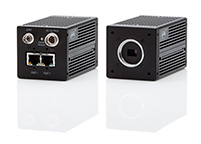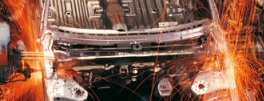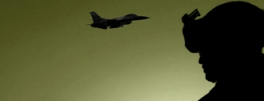|
||||||||||||||||||||||||||||||||||||||||||
|
||||||||||||||||||||||||||||||||||||||||||
Providing more than twice the high-dynamic
range of standard cameras
Go to AD-081GE
Go to High Resolution Monochrome
Cameras
Go to GigE Cameras
Go to 2CCD Cameras
Go to JAI Cameras
JAI's 2CCD camera has built-in modes for image fusion, double frame rate, low noise and more
 |
Left: Automotive
inspection - vision can
be applied directly not only on the assembly line but also in many
other points in the manufacturing process such as inspecting welding
quality Operating in the visible spectrum and designed around 2-CCD monochrome, progressive scan, prism-mounted sensors, the AD-081GE leverages the benefits of GigE Vision/GeniCam technology by adding innovative capabilities and improvements previously unavailable in their the CameraLink version of this camera. |
What value-added features does the AD-081GE offer? |
|
| The advantage of having two sensors |
|
| The advantage
of combining GigE Vision/and GeniCam with the JAI SDK Combining the above allows for a built-in image fusion routines that can automatically produce high-dynamic range output without any post-processing required. The camera uses built-in algorithms to fuse the two images and outputs the combined result. The advantage of using built-in modes Using the camera's user-selected built-in modes provides a quick and easy HDR solution when post-processing resources need to be conserved and minimal fine-tuning is required. |
 |
| All that is needed is for the user to select one of the three available HDR modes and then set the exposure value of each of the CCDs. | Above:
Vision component of JAI's ticketing system for law enforcement |
The advantage of having alternatives Understanding that users may have unique requirements, JAI has added a variety of specialized HDR functions allowing users to offload HDR processing to a host computer and build customised applications to fit their own needs. In addition to the new built-in HDR mode, the AD-081GE features a new High S/N mode that automatically averages the video information from the two CCDs to produce a single image with a significantly lower noise component that a typical single-CCD image. |
|
What are the benefits provided by the AD-081GE's unique HDR/high-speed and core machine-vision capabilities |
|
 |
Image-Fusion software The AD-081GE makes it easy to capture HDR pixel data and convert it for display on standard monitors, which, typically can't support greater than 8- or 10-bit raw data Linear Output Many CMOS HDR cameras use logarithmic methods to compress 16- or 20-bit scene information into 8- or 10-bit pixel data on the sensor. However, this allows the high-dymanic range scene to be displayed at the expense of losing the true values of the 20- |
Above:
JAI high-resolution camera technology can be applied in high-end
security surveillance applications |
bit pixel scale. By using two CCDs, the camera is able to capture a linear representation of true 20-bit pixel values for machine-vision processing while converting those values in a way that can be displayed on standard monitors. |
| Precise CCD alignment
for HDR motion capture The camera's prism-based design guarantees alignment of the two CCDs to within a quarter pixel accuracy, enabling a full 30 fps HDR performance with no ghosting or parallax issues on moving objects. Better analysis of ultra-fast events Unique"3-frame" Particle Image Velocimetry (PIV) trigger modes leverage the camera's two-channel design to capture three closely-spaced images on a single trigger instead of the two captured by conventional PIV trigger modes. This allows 50% more data to provide better analysis of ultra-fast events. |
|
| How can I use the AD-081GE? | ||
| Industrial
applications |
Medical
applications |
Research
applications |
The AD-081GE
has applicability to being used in very-high
contrast lighting situations for example, indoor/outdoor
surveillance, traffic applications, welding, glass inspection or in
applications involving lasers or laser grids. The cameras can also be deployed to collect and analyze ultra-fast events such as vortex forming in artificial heart chambers, combustion analysis in engines and airflow studies in wind chambers. it is also ideal for a wide range of automotive applications and microscopy. In all situations, the parameters of each CCD can be adjusted by the user to provide maximum dynamic range or maximum contrast/sensitivity within a narrower lighting range, depending on the application. The camera's high frame rate mode is suited to applications involving the examination of fast-moving objects with high image quality; for example, the three-image PIV mode is useful in the study of a variety of gaseous or liquid flow phenomena. |
||
| Quick Specs | AD-081GE | |
| Resolution | 1024 x 768 |  |
| Frames per second | 30 fps (HDR mode) and 60 fps for interleaved high frame rate operation* (see below) | |
| Sensors | 2 x prism-based, CCD 1/3" progressive scan sensors | |
| Output | 8-bit, 10-bit or 12-bit per channel | |
| Pixel size | 4.65 µm square | |
| Interface | GigE Vision | |
| Lens mount | C-mount (use 3CCD type, Max. 4.0 mm thread) | |
| Dimensions | 55(H) x 55(W) x 98.3(D) mm | |
| Weight | 320 g | |
| Power | 12V - 24V DC ± 10%. 7.6 W typical. (full frame @ 12V) | |
* The high frame rate mode interleaves the images from the two CCDs into a single output stream. This mode enables the camera to operate at an effective 60fps without any increase in the clock frequency of the camera and so providing a significantly less noisy image han can be achieved by a 60 fps CMOS 0.8MP sensor.
| Adept Electronic Solutions are 'The Machine Vision and Imaging Specialists and distributor for Jai products in Australia and New Zealand. To find out more about the Jai Camera options or any Jai product, please email us at: adept@adept.net.au, call us at Perth (08) 92425411 / Sydney (02) 99792599 / Melbourne (03) 95555621 or use our online contact us form. |
|
If you like this page, please recommend and share it. |
|||
| More | |||



